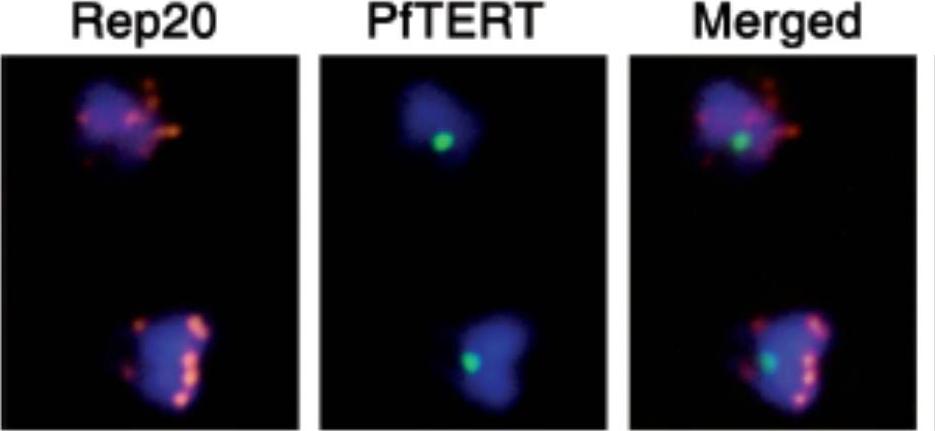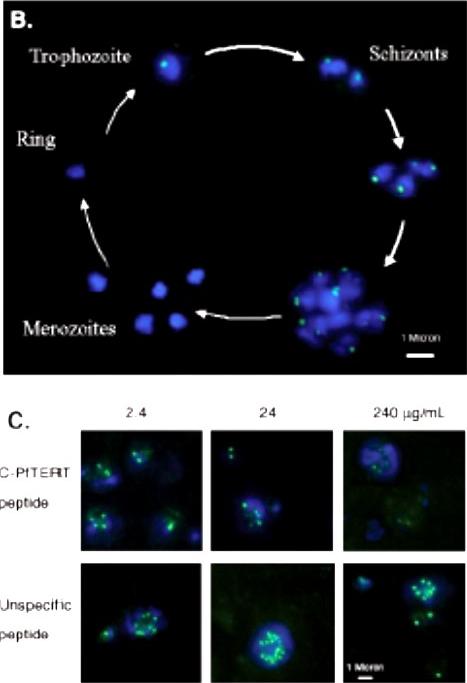PVP01_1415100 telomerase reverse transcriptase, putative (TERT)
Disruptability [+]
| Species | Disruptability | Reference | Submitter | |
|---|---|---|---|---|
| P. berghei ANKA |
Possible |
RMgm-1136 | Imported from RMgmDB | |
| P. falciparum 3D7 |
Possible |
USF piggyBac screen (Insert. mut.) | USF PiggyBac Screen | |
Mutant phenotypes [+]
| Species | Stage | Phenotype | Reference | Submitter |
|---|---|---|---|---|
| P. berghei ANKA | Asexual |
Difference from wild-type |
RMgm-1136
The presence of tert- mutants in transfected populations of blood stages was shown by diganostic PCR. Cloning of tert- mutants has been attempted multiple times without success. Thorough analysis of the transfected parasite populations and the parasite obtained from extensive parasite cloning from these populations provide evidence for a so called delayed death phenotype as observed in different organisms lacking TERT. The findings indicate that TERT is essential for P. berghei. cell survival. |
Imported from RMgmDB |
Imaging data (from Malaria Metabolic Pathways)

PfTERT localizes in a sub-compartment of the nucleolus. (A) IF with an anti P. falciparum Nop1 serum (red) shows the nucleolus as a hat-like structure in the nucleus of a trophozoite stage. An anti-human Nop1 serum (green) recognizes exactly the same sub-nuclear region. (B) Double-labelling reveals that PfTERT (red) co-localizes with part of the nucleolus (green); yellow spot in the merge image. (C) Immuno-EM shows that PfTERT (white arrow head) localizes to a peripheral region of the nucleus. In (A and B), DNA was stained with DAPI (blue).Figueiredo LM, Rocha EP, Mancio-Silva L, Prevost C, Hernandez-Verdun D, Scherf A. The unusually large Plasmodium telomerase reverse-transcriptase localizes in a discrete compartment associated with the nucleolus. Nucleic Acids Res. 2005 33:1111-22. by permission of Oxford University Press.
See original on MMP
PfTERT is not detectable at telomeres. Indirect-IF of PfTERT (green) combined with FISH of Rep20 (red), a sub-telomeric repetitive motif. DNA was stained with DAPI (blue). Both cells are blood stage trophozoites. Figueiredo LM, Rocha EP, Mancio-Silva L, Prevost C, Hernandez-Verdun D, Scherf A. The unusually large Plasmodium telomerase reverse-transcriptase localizes in a discrete compartment associated with the nucleolus. Nucleic Acids Res. 2005 33:1111-22. By permission of Oxford University Press.
See original on MMP
PfTERT localizes in a discrete nuclear region in certain blood stream stages. (B) The 48 h time course in blood stages, during which parasites develop inside an erythrocyte. PfTERT (green) was detected by IF using the rabbit anti-peptide antibody; nuclear DNA was stained with DAPI (blue). (C) Peptide competition assay. The specificity of PfTERT serum was determined by IF after pre-incubating the antibodies with increasing concentrations of a specific (C-PfTERT) or an unspecific peptide. Detection of anti-PfTERT antibodies and staining of DNA was performed as in (B). Studies using rabbit a-PfTERT-peptide revealed no staining in the first 12 h (ring stages). When the parasite matures into trophozoite stage, however, a clear pattern was observed: a single dot within a region of the nucleus. During schizogony, the number of PfTERT foci increased proportionally to the number of nuclei. When schizonts become fully mature (48 h) and merozoites are released into the blood stream, PfTERT was no longer detectable. When the above IF assay was undertaken in the presence of competing epitopes, the PfTERT signal disappeared with increasing concentrations of the C-terminal PfTERT peptide (C-PfTERT); in contrast, when an unspecifcpeptide was used as competitor, the PfTERT signal intensity remained unchangedFigueiredo LM, Rocha EP, Mancio-Silva L, Prevost C, Hernandez-Verdun D, Scherf A. The unusually large Plasmodium telomerase reverse-transcriptase localizes in a discrete compartment associated with the nucleolus. Nucleic Acids Res. 2005 33:1111-22.
See original on MMPMore information
| PlasmoDB | PVP01_1415100 |
| GeneDB | PVP01_1415100 |
| Malaria Metabolic Pathways | Localisation images Pathways mapped to |
| Previous ID(s) | null |
| Orthologs | PBANKA_1412600 , PCHAS_1414500 , PF3D7_1314200 , PKNH_1414800 , PVX_122530 , PY17X_1414400 |
| Google Scholar | Search for all mentions of this gene |